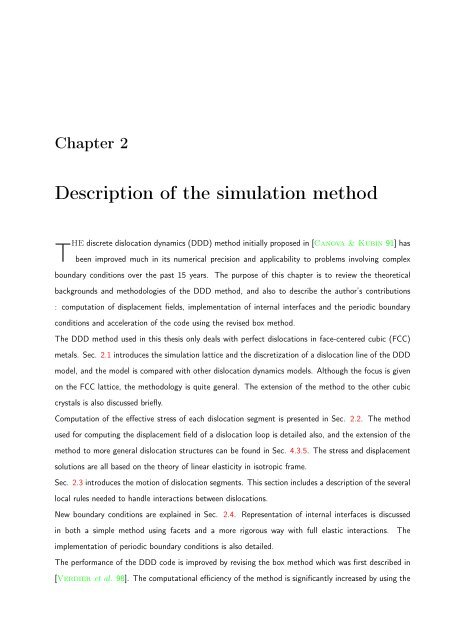3D DISCRETE DISLOCATION DYNAMICS APPLIED TO ... - NUMODIS
3D DISCRETE DISLOCATION DYNAMICS APPLIED TO ... - NUMODIS
3D DISCRETE DISLOCATION DYNAMICS APPLIED TO ... - NUMODIS
You also want an ePaper? Increase the reach of your titles
YUMPU automatically turns print PDFs into web optimized ePapers that Google loves.
Chapter 2<br />
Description of the simulation method<br />
THE discrete dislocation dynamics (DDD) method initially proposed in [Canova & Kubin 91] has<br />
been improved much in its numerical precision and applicability to problems involving complex<br />
boundary conditions over the past 15 years. The purpose of this chapter is to review the theoretical<br />
backgrounds and methodologies of the DDD method, and also to describe the author’s contributions<br />
: computation of displacement fields, implementation of internal interfaces and the periodic boundary<br />
conditions and acceleration of the code using the revised box method.<br />
The DDD method used in this thesis only deals with perfect dislocations in face-centered cubic (FCC)<br />
metals. Sec. 2.1 introduces the simulation lattice and the discretization of a dislocation line of the DDD<br />
model, and the model is compared with other dislocation dynamics models. Although the focus is given<br />
on the FCC lattice, the methodology is quite general. The extension of the method to the other cubic<br />
crystals is also discussed briefly.<br />
Computation of the effective stress of each dislocation segment is presented in Sec. 2.2. The method<br />
used for computing the displacement field of a dislocation loop is detailed also, and the extension of the<br />
method to more general dislocation structures can be found in Sec. 4.3.5. The stress and displacement<br />
solutions are all based on the theory of linear elasticity in isotropic frame.<br />
Sec. 2.3 introduces the motion of dislocation segments. This section includes a description of the several<br />
local rules needed to handle interactions between dislocations.<br />
New boundary conditions are explained in Sec. 2.4. Representation of internal interfaces is discussed<br />
in both a simple method using facets and a more rigorous way with full elastic interactions. The<br />
implementation of periodic boundary conditions is also detailed.<br />
The performance of the DDD code is improved by revising the box method which was first described in<br />
[Verdier et al. 98]. The computational efficiency of the method is significantly increased by using the


